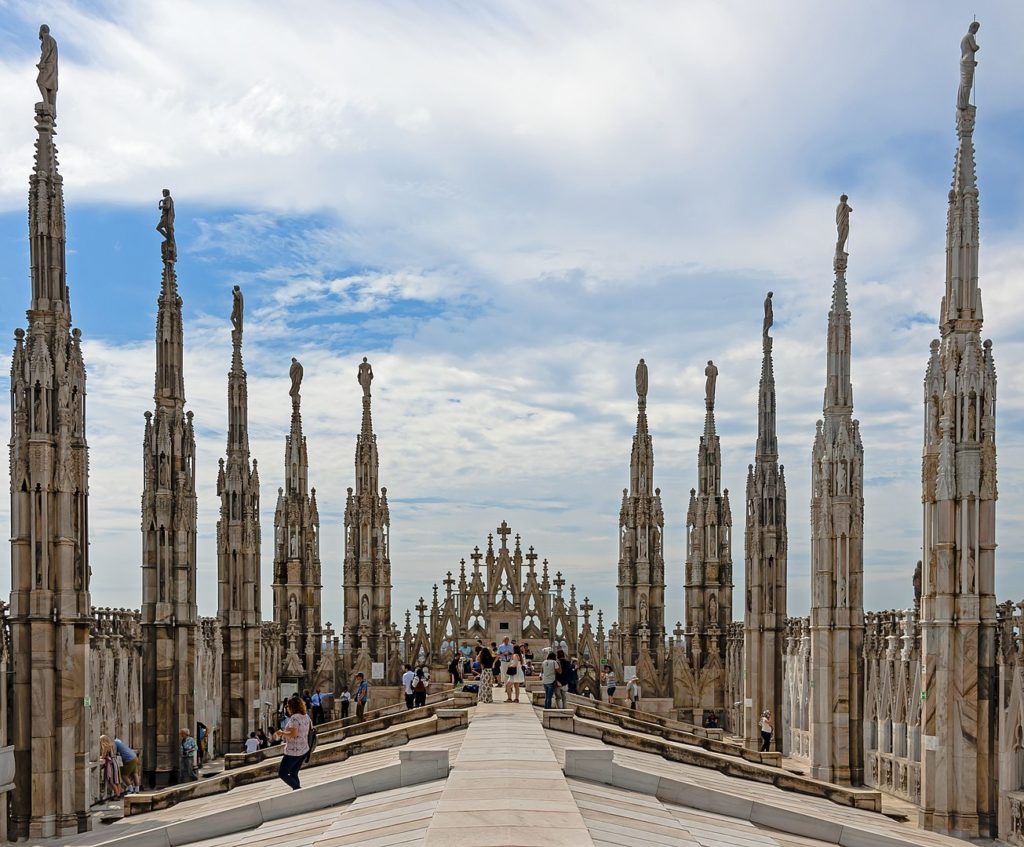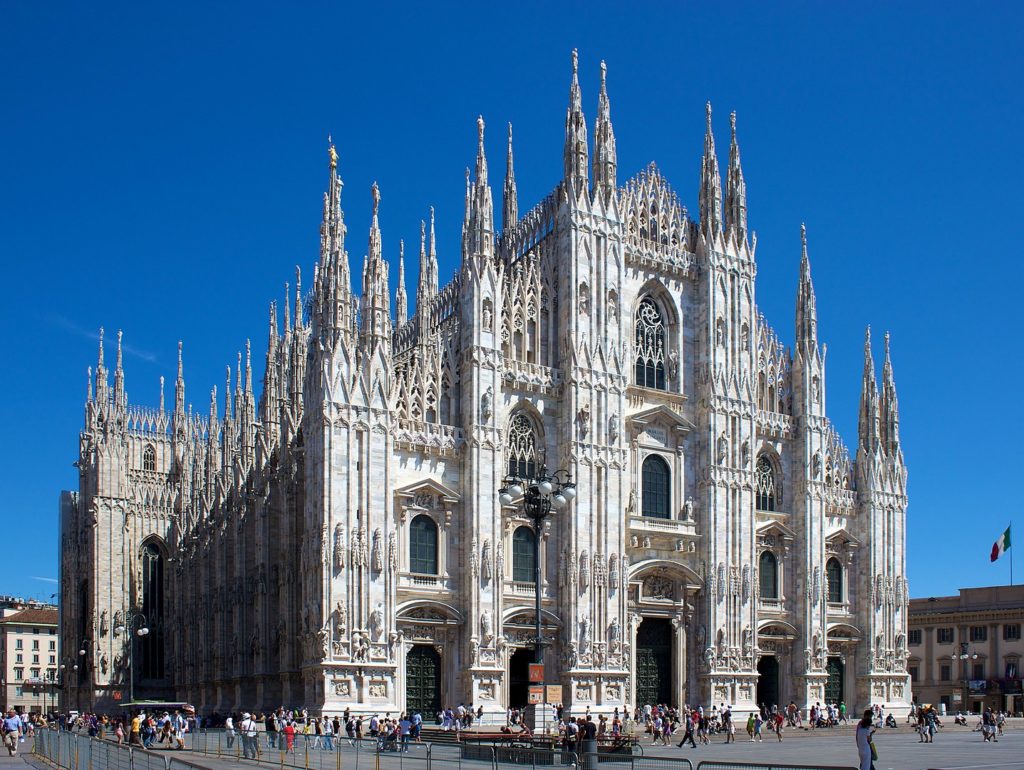
By Daniel Case – Wikimedia
Top 10 Facts about the Cathedral of Milan Duomo di Milano
The Duomo is one of the most impressive structures in Milan. It stands tall in Piazza del Duomo. This colossal cathedral has been around for more than 600 years.
The sight is beautiful, carries with it a peaceful ambience, and attracts a mammoth crowd from all backgrounds and ages.
It is, therefore, a must-see on your next trip to Milan. The locals here call it Duomo although you will not see a visible dome on this Cathedral.
The white façade of the Cathedral has fine carvings that are lace-like all around it. Giving this massive Gothic building a soft appeal.
Duomo di Milano is presently the Archdiocese of Milan as well as the largest church in Italy.
I have put together more facts about this Cathedral. Read more down below.
1. Duomo di Milano was completed after 600 years
Good things take time, right? Well, that’s a true testament to this cathedral.
The construction of the Duomo officially began in 1386 and completed in 1900. It was commissioned by Archbishop Antonio da Saluzzo.
Gian Galeazzo Visconti also funded the construction of the Duomo, he had was the ruler of Milan and had great plans for the cathedral.
The foundation of the Duomo was built using terracotta stone but was later finished using Condoglian marble from Lake Maggiore.
Pink and white marble was used in the entire building.
The marble was brought through canals that were dug from the quarries leading to the Duomo.
Napoleon was the one who finished the façade of the Duomo. This jump-started the construction of the final stages of the Duomo in the 19th century.
2. Thousands worked on the construction of Duomo di Milano

By Alessandro Sanquirico – Wikimedia
Thousands of experts were involved in the construction of the Duomo.
Artists, sculptors, and other specialized workers were commissioned to build the Duomo.
At least 78 architects were consulted for the project. Since the construction work dragged, design changes were imminent.
The Duomo was consecrated in 1418 but only the nave was really finished by that time.
Construction work continued for another 200 years. To continue with the spectacular project, they had to employ architects, sculptors and stone-cutters.
They were sourced from outside Italy; these group of builders were expert in the Central European Gothic style. They are credited with the Duomo’s unique Gothic architecture.
3. Duomo di Milano’s original architect is not known
So many architects were consulted regarding the design and construction of the Duomo.
Today the records in the Duomo indicate that hundreds of architects contributed to the creation and restoration of the building between 1387 and 1988.
They are yet to trace the name of the architect who worked on the initial design of the Duomo.
Several architects, artists or sculptors that met on this site, used the time to exchange ideas.
They exchanged skills and experiences since they came from different parts o the continent.
The design of the church’s façade began towards the end of the 16th century. This was when the foundations for its front were laid.
4. Leonardo da Vinci was part of the artists commissioned
Towards the end of the fifteenth century, some of the greatest architects and artists of the time were assigned different roles in the construction of the Duomo.
One of the notable artists was Leonardo da Vinci. He attempted to work on the difficult task of designing the Tiberium.
Leonardo had a wooden model made; he had worked on it several times.
It proved not to be easy to create a lantern of that size, especially since the building was designed and built by others.
Leonardo finally decides to withdraw the model, with the hopes of presenting it again.
Traces of his contribution to the Duomo can be seen through the drawings of the Atlantic Code, Trivulziano Code and in the Veranda’s registers.
This was gifted to him together with the carpenter who helped him.
5. Construction of Duomo di Milano stalled

By Jiuguang Wang – Wikimedia
In 1418, the Duomo was consecrated because the construction work was taking longer than expected. By that time, only the nave was finished.
By the end of the 1400s, the construction was stalled. This was despite half the cathedral being complete in 1402.
Several factors influenced the stalling of the Duomo such as politics, design changes and lack of money.
This frustrated the construction process leading to endless delays.
Napoleon came to the rescue when he finished the façade of the cathedral. This was done in preparation for his son’s birthday.
6. The Duomo gave way to Navigli Canal

By Brina CRS – Wikimedia
The construction of the Duomo positively affected the city beyond its walls.
The material used to build the cathedral was the white-pinkish marble that comes from the Candoglia Quarries. The quarry is located roughly 90 km to the northwest of Milan.
The architects and masons had to devise ways of transporting the marble to the site fast.
They used the available means of transport then, the water.
The marbles were navigated to Milan along the rivers and canals were built where the rivers ended.
After the construction was completed, the canals remained and became an attraction.
Nowadays, the Navigli canals, are part of the city lined with bars, shops and street markets.
7. Duomo di Milano has the most statues
This Cathedral has the most statues in the world. The beautifully sculpted statues are found on the facade, at the spires and inside.
There are 3,400 statues plus 700 marble figures, and 135 grotesque gargoyles.
Most people that visit the Duomo are impressed by the statues and take their time to notice each of them.
There are not only biblical figures and saints but also a portrait of Benito Mussolini. One of the statues resembles the famous Statue of Liberty.
8. The roof of the Duomo is accessible

By Daniel Case – Wikimedia
Unlike most other historic monuments in Italy, the Duomo lets you climb to the actual roof. Other historical buildings have a viewing tower.
The view from the roof offers a panoramic view of the city. On a clear day, one can see as far as the Alps in the north.
This is the best place in the city to watch the sunset and the night sky since they offer night tours of the rooftop.
9. Jesus’ crucifixion nail is in Duomo di Milano
One of the three nails that was used to pin Jesus on the cross is found here.
This holy nail is kept in the dome above the apse marked by a small red-light bulb.
The nail is removed every year and shown to the public for three days. This is usually during the celebration known as Rite of the Nivola.
A lift is used to access the nail, it was created by Leonardo da Vinci who did not like climbing the ladder.
10. The sundial at the Duomo is still accurate
At the main entrance of the Duomo, there is a sundial on the floor. There is a hole on the opposite wall from which a ray of sunlight shines through and strikes the clock.
This happens on June 21, during the summer solstice, and the meridian on the winter solstice, on December 21.
Although the sundial is ancient it still works and is used to regulate clocks throughout the city.
Bonus fact
11. Bartholomew’s statue is inside the Duomo

By Frank Schulenburg – Wikimedia
Among all the thousands of statues at the Duomo, one of them will definitely catch your eyes.
It is that of Saint Bartholomew, he was one of Jesus’ apostles who was skinned alive for preaching the gospel.
His statue is inside the cathedral where is holding a book and is draped in his skin.
Planning a trip to Paris ? Get ready !
These are Amazon’s best-selling travel products that you may need for coming to Paris.
Bookstore
- The best travel book : Rick Steves – Paris 2023 – Learn more here
- Fodor’s Paris 2024 – Learn more here
Travel Gear
- Venture Pal Lightweight Backpack – Learn more here
- Samsonite Winfield 2 28″ Luggage – Learn more here
- Swig Savvy’s Stainless Steel Insulated Water Bottle – Learn more here
Check Amazon’s best-seller list for the most popular travel accessories. We sometimes read this list just to find out what new travel products people are buying.










